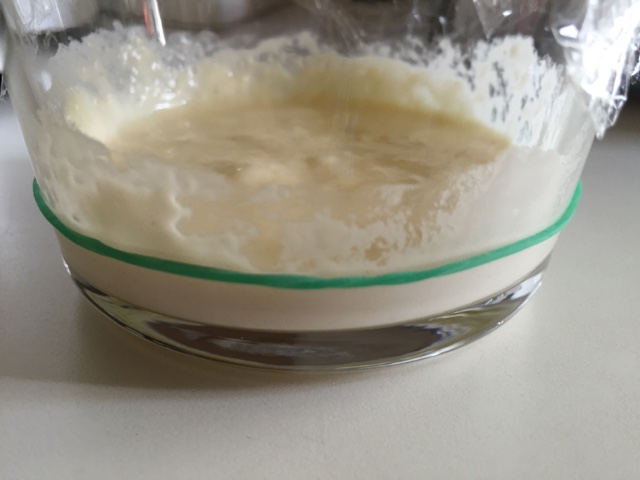Before I came into contact with natural yeast bread, this type of bread seems mysterious, complicated and confusing to me, not until I bought the recipe book which introduced me to "No-knead Natural Yeast Breads". The quest for a bottle of good natural yeast was a challenging experience. I failed thrice to cultivating natural yeast using flour and water. Frankly speaking, this method of cultivating natural yeast was horrible in terms of smell. Finally, I decided to use lemon as a medium. I successfully cultivated the yeast, but could not identify the right time to do the transfer to flour and water base starter. That's why I'm not sharing the yeast cultivating process for the time being.
Using autolyse and fold method of kneading is new and interesting to me. I didn't expect the first loaf of bread to have such a good, soft and moist texture. The steps are easy, but you must have the time for the pull and fold sessions in every 15-minute interval for about four to six sessions. In my opinion, this is not a totally no-knead method, it still involves some forms of light kneading, so I would prefer to call it easy-knead instead of no-knead bread :)
Bread weight: 667 g
Raw dough weight: 715g
Yield: one 20x10x10 cm loaf
Natural Yeast (100% hydration)
Ingredients
15g natural yeast
60g water
60g unbleached bread flour
Click the link for the method of cultivating natural yeast:
Directions
1. In a sterilized and dry glass container, pour in all the 3 ingredients and mix well.
2. Close the lid tight and allow to stand overnight, or till the content double in volume. This may take about 3 to 8 hours depending on the yeast strength.
12 hours later, the content has more than double in volume.
3. The next morning, in order to "wake up" the yeast, I added a small amount of water and flour to activate it.
Added 10g water + 10g flour, and waited 1 hour for the volume to double.
4. Collect 110g natural yeast for later use.
Bread dough
Ingredients
All ingredients in room temperature
309g bread flour
24g full cream milk powder
28g raw sugar
1 tsp salt
1 tsp instant dry yeast
30g unsalted butter, softened
28g beaten egg
110g natural yeast *
182g water
* natural yeast can be replaced by 55g water and 55g of bread flour, if you're not using natural yeast.
Directions
1. Pour all the ingredients into a mixing bowl.
2. Stir in one direction until the mixture forms into a lump and pulls away from the wall of the mixing bowl.
3. Cover with a lid and let the mixture autolyse for 15 minutes.
4. After the 1st 15-minute rest, grasp one corner of the dough, pull it up and fold it towards the centre.
Take care not to break the dough while you extend it.
1st pull & fold session.
Continue this pull & fold for about 6 times round the dough.
Picture showing dough after the 1st session last fold.
Cover with a lid and wait for another 15 minutes.
Repeat the pull & fold session for about 4 to 6 sessions, or till the dough can be extended to form a membrane.
Picture showing 4th pull & fold season. The dough will become smoother and smoother.
15 minutes after the 5th pull & fold session, the dough can be stretched to form a thin membrane.
5. Pull down the side of the dough and tug at the bottom to shape the dough into a smooth ball.
Place the dough back to the mixing bowl, cover with a lid, and let it undergo the 1st proofing for about 45 minutes, or till it doubles in size.
6. Sprinkle flour over the dough as well as the work top. Invert out the dough and deflate it with your palm.
7. Divide the dough into 3 portions, about 238g each.
Roll up the doughs, and shape them into 3 balls. Cover with a lid and let them rest for about 10 minutes.
8. Flatten the dough with a rolling pin,
fold in the two wings,
Roll it out again
flip over the dough, so the smoother face with be facing out when roll up.
9. Place the roll-up dough into a greased 20x10x10 cm Pullman tin. Spray some water over the dough, and place in an oven to undergo 2nd proofing for about 45 minutes, or till the dough almost reaching 4/5 of the Pullman tin height.
10. Close the lid and bake in an preheated oven at 210 degree Celsius for about 40 to 50 minutes. Place the Pullman tin at the lowest rack.
11. The bread is ready when the crust turns golden. Remove the bread from the tin and cool down over a wire rack.
12. Slice the bread after cooling down :)
By keeping the bread in the fridge during the nights , the bread remained soft till the 4th day.
2nd day
4th day
Recipe adapted from page 27 to 29 of the following recipe book :)



















































































































